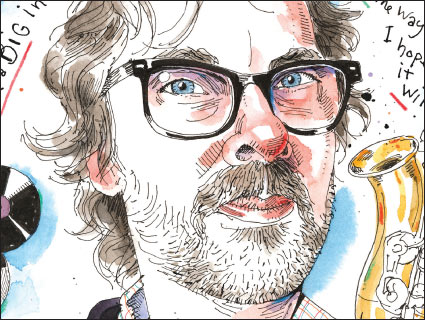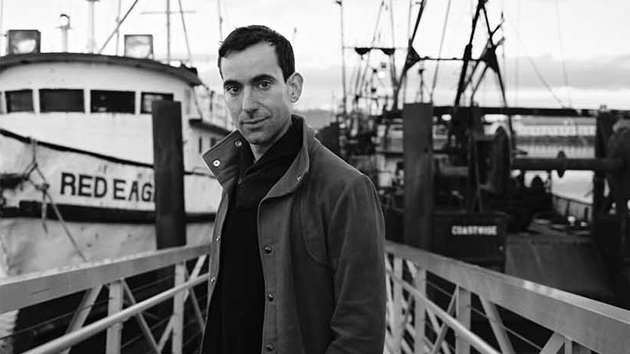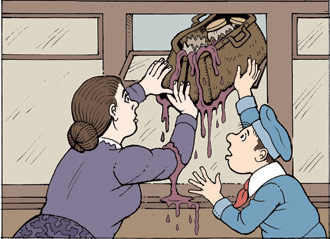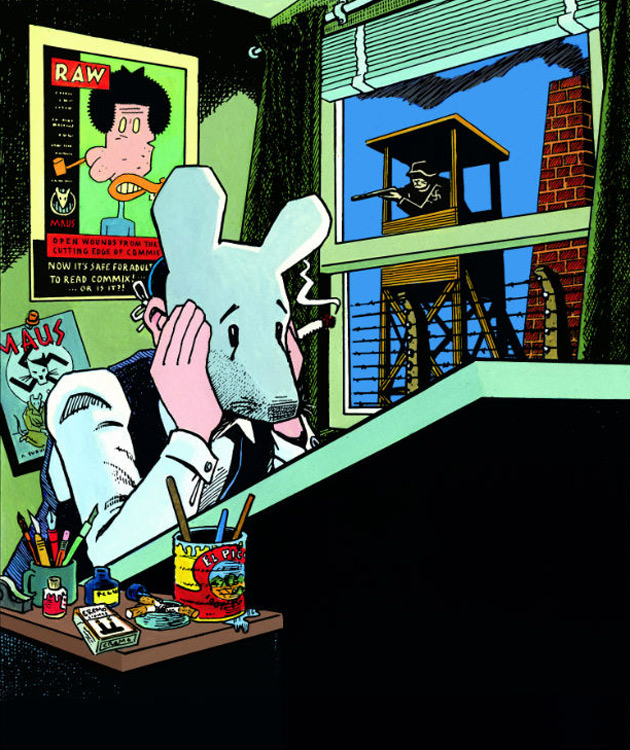
Self-portrait with Maus mask, 1989Courtesy of Pantheon Books and The Wylie Agency LLC.
Over his six-decade career, Art Spiegelman, the comic artist best known for his Pulitzer Prize-winning Holocaust memoir Maus, has pushed the boundaries of his genre via cultural provocation, experimental storytelling, and keen editorial oversight of the anthological classics Arcade and Raw magazine. Some of his most noteworthy and provocative work can now be seen in a major retrospective that runs through March 23 at the the Jewish Museum in New York City.
For those who can’t make it to Manhattan, though, there’s the accompanying book, Co-Mix: A Retrospective of Comics, Graphics, and Scraps, which showcases and contextualizes Spiegelman’s collection and gives an impressive overview of his career. I caught up with the esteemed artist to talk about life after Maus, his rejected New Yorker covers, and how Mad magazine shattered Norman Rockwell’s America.

Mother Jones: What first drew you to comic books, and how did you decide you wanted to draw for a living?
Art Spiegelman: Well, the words “for a living” weren’t there at first, of course. I think as soon as I figured out—and this must have been incredibly young—that comic books were made by humans, rather than being natural phenomenon likes trees or rocks, I just wanted to be one of the people who did that. So I was copying all kinds of cartoons that I was reading, comic books, and eventually learned how to draw cartoon books step-by-step and just, I don’t know, I’m not an especially quick learner, but I sure was a dedicated one.
MJ: Did you intend your work to be rebellious or provocative, or did that just sort of happen?
AS: Well, it happened by the inspiration of the first thing that really kind of tipped me over the edge, which was Mad magazine. It was really electrifying. It’s hard to understand in a world that’s gone all ironic all the time how significant a zeitgeist shift Mad brought into the world back when the monolithic 1950s was like the Norman Rockwell way or the highway. There wasn’t a dissenting voice. Now, I would say everyone learns from Mad, including Karl Rove—God curse his miserable hide. We’ve gotten to the point where we have to relearn how to be sincere, but with all the tools of irony that Mad brought into the world.
MJ: Much of your earlier work with Underground Comix and Raw is lewd or absurd or sexual in nature. What was your mindset back then?
AS: I mean, there’s some pictures I guess somebody could get upset by in Raw, but for the most part it was really that underground moment that very consciously was attacking the Comics Code of America by trying to break every one of its stipulations, almost as if it was an agenda. As a young underground cartoonist trying to learn from my betters, I tried to get with the program.
MJ: Is it strange for you to see, with this particular collection, what had previously been thought of low-brow art on the walls of a museum?
AS: Yeah, of course. I was attracted by the marginality of comics. It’s great to be outside the law; it keeps you honest. But the truth of the matter is that from the ’70s on, maybe because I’m a just-under-middle-middle-class kid, I had the social aspirations and wanted the validation and the rewards that could come with cultural benedictions, and worked toward it—even, I would say, consciously.
I read in one of these books Marshall McLuhan had written about how when a technology, i.e. medium, becomes no longer a mass medium, it becomes art or it disappears. Comics were no longer in a central arena of the culture the way they had been in the years before the Comics Code. It seemed like it would be useful for us outlaw comics types to make peace with that culture on some level—a Faustian dangerous deal—if one could actually make it into a world where book stores, libraries, universities, museums, and galleries would allow this bastard form into their midst.
So be careful what you wish for: We succeeded, and I knew that would have the downside of making comics all too respectable, perhaps, but I figured if the medium stays alive and healthy and can find some support outside the capitalist marketplace, then there’s room for artists who make comics who can be ranting against the institutions.

Courtesy of Art Spiegelman and The Wylie Agency LLC.
MJ: Do you think that’s necessarily a good direction for art? Take somebody like Banksy, who borrows from this culture of graffiti and street art and turns it into an object of an upper-middle-class fascination that largely sells to them.
AS: I actually think some of what he does is very interesting. It’s provocative in a fine way, like the time recently when he was occupying New York on his own without the Wall Street occupiers having his back—he did this thing of selling his artwork on a kiosk at the edge of Central Park for almost no money at all, thereby proving what bullshit the signature is. Nobody wanted it at $50 bucks apiece. That’s admirable, isn’t it? It’s a lot more interesting than figuring out how to get someone to pay $50,000 for a dried banana peel that they found.
MJ: In one of my favorite Art Spiegelman quotes, you were describing your relationship with Judaism by saying you aligned with the “alienated diaspora culture” of Kafka, Freud, and etc. and that you felt a sort of “rootless cosmopolitanism.” What do you think led to that?
AS: I think I am the beneficiary, because of my parents’ experiences, of the monstrous results of nationalism. The “rootless cosmopolitan” thing—although it was an anti-Semitic slur born in the Stalin era, I believe—basically is the idea that you make yourself at home and make use of whatever culture you’re in, and that seems about right. I feel much more comfortable in cosmopolitan rather than rural areas, certainly, and I prefer that they be hosts that don’t try to kill you.
MJ: New York City has been a recurring theme in your work.

AS: To me, New York has been, at least until recently, the rootless cosmopolitan capital of America: Not [just] Jewish, but African, Chinese, and everything in between found itself here. It’s a rich culture, and I’ve been most comfortable here despite the San Francisco I lived in with a band of underground cartoonists back in the day. The call of the wild brought me back. Now I don’t know what New York is, because the real estate’s so damn expensive that you can’t have artists here.
MJ: You’re seeing an exodus of the creative class?
AS: What I’ve seen recently is the creative class finding a way, like the rest of the culture, to peddle in capitalist ventures of one kind or another so they can afford to be where they want to be, and it gets harder and harder and harder. The process of gentrification now takes about eight minutes.
MJ: As someone who created a book about living in and out of the shadows of the Twin Towers, how do you feel about the new World Trade Center?
AS: I’m horrified by the new building, especially because my wife—the art director of The New Yorker—might end up working there. I think it’s an arrogant, stupid thing. It’s the equivalent of putting a “kick me harder” sign on top of a building. We need middle-class housing in New York. Somebody, help! We don’t need another office tower—a giant one that proclaims our majesty.
MJ: What made you identify with the old WTC complex so much?
AS: Only that it was taken away from me and it was in my neighborhood. It’s not like I loved the buildings. I didn’t spend much time there. It had more to do with feeling the horror. I certainly didn’t like people getting killed who had nothing overt to do with the problems that might have led to this particular horror show. I certainly didn’t want to go to war over it afterwards. Man, even if it’s a gnarled tree in your backyard, you don’t want somebody blowing it up.
MJ: When I first read Maus, I had a strong personal reaction to it. I was surprised how new and visceral the story felt even though I had learned about the horrors of the Holocaust long before. What do you think made Maus resonate the way it did?
AS: Comics have a kind of intimacy that makes it feel like two people are talking, in a way, even though there’s a hell of a lot of work in putting together the vocabulary with the cartoonists. There is a kind of I/thou relationship that moves into your brain comfortably because of the stripped-down images that comics ask for and the stripped-down language that will fit into a balloon that allows it to enter deeper into your brain more than prolix prose or photographs. As my wife said, looking up from a Science magazine she’s reading, “Hmm, a baby can recognize a Have a Nice Day smiley face before it can recognize that its mother is smiling.” So that means we’re wired to understand a certain kind of cartoon imagery.
MJ: You recall Maus in a lot of your contemporary work. There’s one print of you wearing the Maus mask and being pushed on by die Katzen in the background. Do you feel limited by Maus and what it became?
AS: That was done right after Maus was finished. Maus, when I first was working on it, I was looking for something narrative enough to hold people’s attention because I was moving in more and more rarified, formal directions through my interest in comics. I figured, “Okay, if I agree to just tell a story, that’s what people want out of a narrative medium, Spiegelman.” This was one that seemed like it would hold water. I entered into it at a moment where there wasn’t a lot of Holocaust popular culture, but I never expected it to become a crossover hit. I figured there’d be some people who would read it, and I was grateful for that.
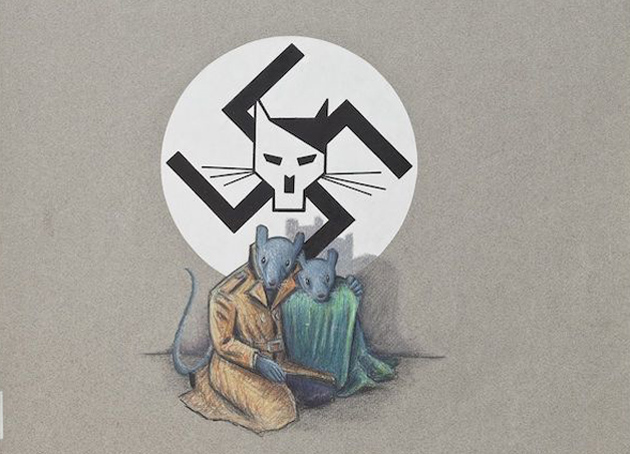
By Art Spiegelman, courtesy of Pantheon Books and The Wylie Agency LLC.
I just felt like I’ve had a 5,000-pound Maus chasing me ever since. I’m proud of Maus. I’m proud that I was able to make it, that it came through me. On the other hand, it inevitably shadows everything else I’ve done after and towers over what I’ve done before in ways that sometimes seems unjust to me. And yet I understand exactly why that should be. That’s why I’m grateful to have this retrospective that has Maus cradled in the center, but shows the trajectory that led to, through, and out of it, with me, yes, being constantly trying to renegotiate my place in the world in the shadow of Maus.
MJ: You went on to do this amazing series of covers you drafted for The New Yorker—some whimsical, some political. In one, a Muslim family is sitting down to Thanksgiving dinner, sort of Norman Rockwell style, and there’s a brick thrown through their window. I thought it was a spot-on response to Islamophobia.
AS: It’s a cover that didn’t run. It was rejected by me. I had another cover that ran that week: a bunch of Thanksgiving turkeys being dropped on Afghanistan at the moment when they were also dropping leaflets saying, “The round packages are food, they are Halal. Feel free to eat them. The square packages, please avoid. They are landmines.” That was our intervention there.
It didn’t fly.
That happened in the immediate wake of 9/11. My first response was being horrified that a Sikh newsdealer had his whole place trashed in our neighborhood—here in beautiful and benign SoHo—because someone saw him wearing a rag on his head. Then I started working on this picture that was specifically dealing with a Norman Rockwell idea of Thanksgiving. But at the same time, I’m hearing all these Muslim spokespersons explaining how “the Jews did it, not the Muslims, they bombed the World Trade Center. There were no Jews inside the towers because the Jews had a network where they explained, ‘Stay away from the World Trade Center on the morning of September 11.'” This kind of anti-Semitic crap made me go, “You know what? Find your own fucking cartoonist!”
So I just pulled the cover and did something else that also was really horrifying to me, which was our Afghanistan adventure.
MJ: In the retrospective, we see a bunch of other covers that were rejected as well. Did you pull those as well?
AS: No. Mostly it was pulled for me, thank you.
MJ: How come? Do you have any insights into that?
AS: I try to stay away from watching how the sausages are made. I would say that there’s only room for one cover and there are usually a number of suggestions, so some of them are just like somebody liked that cover better. On the other hand, some are obviously pushing the envelope, and sometimes the envelope can get pushed too far.
This one cover I still regret these many years later. It was right during the Clinton-Monica Lewinsky affair, where they had just started doing impeachment hearings against Bill. I had a picture of Blind Justice wearing an S&M ball gag and leather blindfold. Had that run it would’ve been out on the stands the very week that Larry Flynt, a pornographer, came out of the woodwork to save us by saying, “If you go ahead with this, I’m just gonna’ release all the names of the various scandals and love affairs that exist among the Senate and the House.” I would’ve loved to have this image out when that statement was made!
It didn’t fly. What can I do? It has become harder and harder for me to enter into the dialogue, because I find that when pictures were accepted that were in the envelope-pushing tradition—an envelope-pushing tradition, I might add, that I instituted at The New Yorker—the result was either to have it rejected and feel devastated by the rejection, or the equally likely probability that I would have to defend it as if I was a lawyer rather than somebody who drew it. It was exhausting. Because I have a fragile ego, I find the process of submission very difficult.
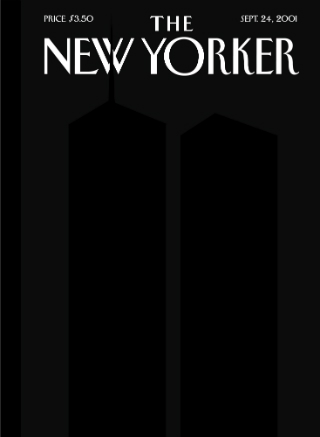
MJ: How do you view the role of art in contemporary society?
AS: It depends what we mean when we say “art.” If you mean the real basic impulse toward making something that actually has no use value and can be something to be contemplated and be beautiful or contemplated and be provocative, that’s all on a spectrum that is the flower that sits on top of the garden of our and every other culture. If you’re talking about what art actually is now, I can only quote Chris Ware, good friend and genius, who said for a while he just thought art was a historical term. What’s called art now probably has some legitimate things happening in it, but I’ve become more and more distrustful of a lot of it because it seems like an extension of the fashion trade and the stock market.
MJ: Like that “Punk Couture” exhibit at the Met not long ago?
AS: Yeah. But that’s only an overt symptom of something that exists on the rest of the art planet as well, which is these things come now in waves of fads—the Banksy fad, that’s a good one—and there’s one every 10 minutes, because fashion can only function if the hemline gets longer and shorter every season.
MJ: How does it feel to have a retrospective of your career?
AS: It’s an incredible amount of retrospecting! It’s driving me nuts.
MJ: Do you think it represents you and your work pretty well?
AS: Yeah, for better or for worse. It’s about half the size now that it was, but it’s possible to see in these few hundred pieces. If you don’t like those, I got nothing you will like. So there’s that, and it’s not like I’m that prolific. It’s just I’ve been alive long enough to seem prolific.
MJ: What’s next? If anything?
AS: I really don’t know. I’d like to think that F. Scott Fitzgerald’s line about America and second acts is wrong. I understand that [Willem] de Kooning said never have a retrospective while you’re still alive. But then I found out that he had two and he still managed to keep going. So I don’t know. Maybe I’ll be a senile de Kooning, making my crazy comics as dementia sets in on the old coot. But I will be about to find out because the little 10 second spotlight of attention will soon be passed and I’ll still be here glaring at a piece of paper and watching it glare back at me.
